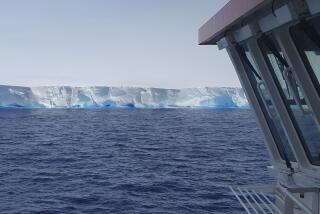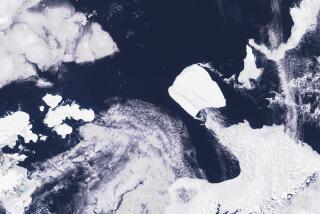All 950 Aboard Liner Safe; Ship Limping to Port
- Share via
OSLO — A Norwegian coast guard ship cut through thick Arctic ice Tuesday to rescue hundreds of people who had taken refuge on ice floes and in lifeboats after their Soviet cruise liner hit an iceberg and took on water. All of the nearly 600 passengers were reported safe.
“All the passengers are now off the vessel and only (some of the) the crew remains,” said Arne Finne, a spokesman for the Rescue Center in Bodoe, Norway.
Late in the day, some of the Soviet crew members--who had remained aboard the Maxim Gorky--stabilized the badly listing vessel and sailed toward port with the help of a coast guard ship and several pumps flown from Norway.
740 Reach Spitsbergen
Early today--more than 25 hours after their ordeal began--about 740 passengers and crew of the estimated 950 aboard reached the Norwegian Arctic outpost at Spitsbergen, officials said. Passengers were taken to the airport on the tiny island of 1,000 people for chartered flights back home.
About half of the Soviet crew had worked to keep the 630-foot ocean liner afloat in the Norwegian Sea, about 185 miles west of Spitsbergen, while the rescue ship and helicopters saved passengers huddling in blankets in the near-freezing temperatures. There were no reports of serious injuries.
The Maxim Gorky rammed the iceberg in the foggy Arctic twilight shortly after midnight, when many of the passengers were partying in a shipboard nightclub.
“Suddenly there was a terrible crash that almost shook me from my bed,” said Rudolf Ludwig, 67, of Wiesbaden, West Germany, one of the passengers on the midnight sun cruise who was evacuated by helicopter to Norway’s Svalbard island.
“We were told to get into the lifeboats,” Ludwig said. “We sat for five hours among the icebergs. The atmosphere was calm, and the Russian sailors did everything they could. They gave us vodka and whiskey in the boats, since it was cold. And blankets, too.”
West German passenger Win-fried Prince said there was no panic, and “the Russian crew has worked perfectly in disembarking passengers into lifeboats, and also the Norwegians who picked us up . . . have done a wonderful job.”
Ripped Two Holes
The accident occurred early Tuesday when the iceberg ripped two holes in the ship, which quickly took on water. Passengers said three decks became submerged.
The coast guard vessel Senja, its bow reinforced for ice-breaking, rushed to the site about 300 miles east of northern Greenland. It reached the area after about four hours to begin rescue work. Soviet ships arrived later to continue the operation.
Although reports of the number of people aboard the liner varied, the agency that chartered the vessel said there were 953 aboard--575 passengers and 378 crew.
Johannes Zurnieden, manager of the Phoenix-Flugreisen tourist agency in West Germany, said all but 16 of the passengers were West Germans. The others included Austrian, Swiss, Italian, British, Dutch and Swedish passengers.
Clambered Into Lifeboats
After the accident, about 350 passengers clambered into lifeboats and some were taken to ice floes before being plucked to safety by Norwegian and Soviet helicopters. They later were moved onto a Norwegian rescue vessel in the Barents Sea, the coast guard said.
The estimated 200 passengers who had remained aboard the 25,000-ton vessel were evacuated and picked up by the Senja.
The captain of the Senja, Sigurd Kleiven, said the Maxim Gorky had two gashes in the starboard hull, one measuring 30 inches by 8 feet and the other 2 inches by 19 feet.
Kleiven said that after his ship’s arrival, two of the Senja’s pumps were taken aboard the crippled liner. One pump later broke down.
Divers inspected the gashes, but there was nothing available to plug them with, Kleiven said.
Later, Finn B. Hansen of the North Norway Rescue Coordination Center said the Soviet tugboat Sarja arrived with more pumps and two more vessels steamed toward the site.
“It looks like there is enough new pumping equipment aboard to keep it afloat,” Hansen said.
And finally, the crew managed to stabilize the ship despite the gashes and set sail for Barentsburg, 300 miles to the east, trailed by a coast guard ship, officials said.
“Everything is under control, thanks to comprehensive pumping equipment continuously brought to the vessel throughout the day,” a coast guard spokesman said.
The Maxim Gorky had set out June 11 from Bremerhaven, West Germany, sailed to Iceland and, then, while sailing around the Spitsbergen island chain on its way to Norway, struck the iceberg.
The Norwegian Meteorological Institute sends out weekly ice charts of the area, but the situation changes too quickly to be dependable for navigation, the Norwegian news agency said.
Although it was reportedly foggy at the time of the accident, it was not fully dark because the area around the Arctic Circle is light nearly 24 hours a day this time of year.
Seventy-seven years ago, on April 14, 1912, the British luxury liner Titanic hit an iceberg just south of Newfoundland on its maiden voyage. Of 2,224 people aboard, 1,513 died.
Fared Better
Steinar Breivik at the Bodoe Rescue Center said the Maxim Gorky fared better because damage to the Titanic was apparently much worse and because the Soviet vessel “received pumping equipment within a few hours, both from land and from other ships.”
The Maxim Gorky was built in West Germany in 1969 and sold to the Soviet Union in 1974.
The Soviets have been involved in the cruise business for foreigners for about 15 years. The Soviet merchant fleet began expanding passenger liners for the cruise trade as well as purchasing new ships during the early ‘70s.
The collision with the iceberg is the latest disaster or near-disaster reported openly under Soviet President Mikhail S. Gorbachev’s reformist policy of disclosure of events.
In the worst Soviet shipping disaster, the cruise ship Admiral Nakhimov was rammed by a grain freighter in the Black Sea in August, 1986, killing 398 of 1,236 people aboard.
More to Read
Sign up for Essential California
The most important California stories and recommendations in your inbox every morning.
You may occasionally receive promotional content from the Los Angeles Times.













